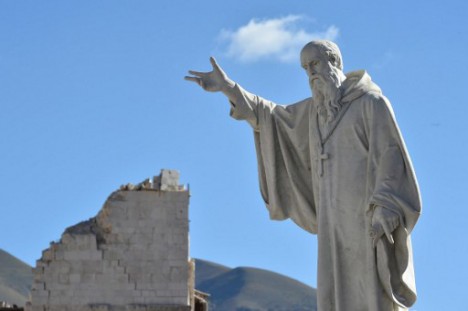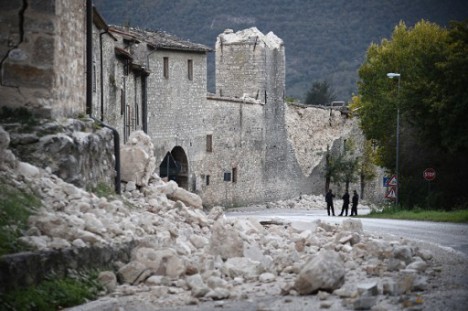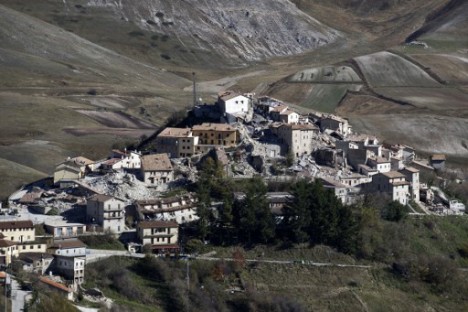After the earthquakes, why you should still visit central Italy

As the earthquake-struck towns of central Italy begin work on reconstruction and recovery, one of the big worries is whether tourists will be scared away by the disasters.
The mountainous region is dependent on tourism, and is well known for its food, culture and natural beauty.
Tourists would normally spend a total of 220,000 nights in the quake-hit zone, according to consumer organization Coldiretti. Shortly after the series of quakes, Coldiretti warned of "tourists fleeing, reservations being cancelled and disastrous expectations for the Christmas period".
Between January and August this year, foreign visitors in Le Marche reached over 945,000; the region's best result in five years. But of the 180 'agritourism' businesses in the area, 120 are in the Macerata while a further 30 are located in Ascoli Piceno and Fermo; all three areas were badly affected by the tremblors.
Mayors in the region set up a task force this week to help revive tourism to Le Marche. The local Bishops' Conference is also involved in the effort, since one of the big draws for tourists is the huge amount of religious and cultural heritage in the region's churches.
Amatrice, the town close to the epicentre of the August 24th quake and which bore the brunt of the casualties, is known for its medieval churches and the regional pasta dish, spaghetti all'amatriciana.
Further quakes in late October fortunately caused no deaths, but caused widespread damage to the region's infrastructure and culture. One of the most important losses was the collapse of Norcia's 14th-century Basilica of Saint Benedict, and Amatrice's 13th-century civic tower - which had survived the first quake - also fell to the ground.

A statue of St Benedict, patron saint of Europe, by the destroyed church. Photo: Alberto Pizzoli/AFP
Life has been turned upside down for those in the area. Judith Mathias, an English citizen living in Le Marche, told The Local she was finding life difficult in the hostel she had been moved to. "It's noisy and phone coverage is intermittent - I need to contact my family," she said. But she was full of praise for local authorities and rescue services, and looked forward to moving back home.
Others living in the area urged travellers not to be put off by recent events.
Denise Abel, from the UK, has lived near Norcia for four years and was relocated to a hotel in Perugia following the quake. She said she was looking forward to return to her Italian home, and encouraged other foreigners to show solidarity with the region by visiting.
“It's an extremely beautiful part of the world, its people warm and welcoming and as we have seen in the last months, strong and resilient,” she explained. "This area is dependent on tourism."
Only 25 percent of the buildings in Norcia have been judged fit for use, but the Umbrian regional president, Fabio Paparelli, has set up a tourism task force to promote visitors to the 90 percent of the region which is accessible and ready to welcome visitors. He told local paper Umbria 24 that the region would invest €4 million in tourism and was ready to launch a "strategic plan" in 2014 which would help to "reposition the Umbrian brand".
There will also be specific plans aimed at attracting families and weddings, two groups for which Paparelli believes Umbria is "an ideal destination".

A collapsed town wall in Norcia. Photo: Filippo Monteforte/AFP
Revenues from tourism are more important than ever as the towns face the prospect of multi-million-dollar rebuilds. But plenty of our readers said the earthquakes wouldn't stand in the way of their plans to visit the region.
American Kristin Henley told us she had travelled to Umbria earlier in November. “It’s a beautiful place with great people! I’d return tomorrow if I could.”
Another reader, Martin Harrison, had visited Visso, Ussita, Castelluccio, Arquata and Amatrice on a cycling trip weeks before August's earthquake and vows to return. "We can't allow any of these places to become ghost towns," he said.
"The region is astonishingly beautiful, and it's terrible to see what's happened. Castelluccio in particular was probably the high point of my trip, and top of my list of places to return to. The damage to that incredible village is nothing short of heartbreaking."
"I would never be afraid to visit Italy," added Karen Springer, a teacher from Chicago. Springer said nothing could keep her away from Abruzzo, which is her favourite region after several visits to the country.
She plans to return to Pescara, where she has several friends, in 2017, saying: "The people I’ve met there have become part of my family. I love Pescara because it’s not a ‘touristy’ area - I can live like a true Italian there.”
“It’s my home away from home I love the food, the friendly people, and the warmth."

Castelluccio. Photo: Filippo Monteforte/AFP
The local food - from Norcia's prosciutto to Abruzzese wines - was high on many people's list of reasons why central Italy was well worth the visit. And if you aren't able to visit central Italy, a good way to support the affected towns is to buy local produce.
The Valnerina Online website offers a good list of places where you can buy food from the area, in order to support local farmers and artisans.
Comments
See Also
The mountainous region is dependent on tourism, and is well known for its food, culture and natural beauty.
Tourists would normally spend a total of 220,000 nights in the quake-hit zone, according to consumer organization Coldiretti. Shortly after the series of quakes, Coldiretti warned of "tourists fleeing, reservations being cancelled and disastrous expectations for the Christmas period".
Between January and August this year, foreign visitors in Le Marche reached over 945,000; the region's best result in five years. But of the 180 'agritourism' businesses in the area, 120 are in the Macerata while a further 30 are located in Ascoli Piceno and Fermo; all three areas were badly affected by the tremblors.
Mayors in the region set up a task force this week to help revive tourism to Le Marche. The local Bishops' Conference is also involved in the effort, since one of the big draws for tourists is the huge amount of religious and cultural heritage in the region's churches.
Amatrice, the town close to the epicentre of the August 24th quake and which bore the brunt of the casualties, is known for its medieval churches and the regional pasta dish, spaghetti all'amatriciana.
Further quakes in late October fortunately caused no deaths, but caused widespread damage to the region's infrastructure and culture. One of the most important losses was the collapse of Norcia's 14th-century Basilica of Saint Benedict, and Amatrice's 13th-century civic tower - which had survived the first quake - also fell to the ground.

A statue of St Benedict, patron saint of Europe, by the destroyed church. Photo: Alberto Pizzoli/AFP
Life has been turned upside down for those in the area. Judith Mathias, an English citizen living in Le Marche, told The Local she was finding life difficult in the hostel she had been moved to. "It's noisy and phone coverage is intermittent - I need to contact my family," she said. But she was full of praise for local authorities and rescue services, and looked forward to moving back home.
Others living in the area urged travellers not to be put off by recent events.
Denise Abel, from the UK, has lived near Norcia for four years and was relocated to a hotel in Perugia following the quake. She said she was looking forward to return to her Italian home, and encouraged other foreigners to show solidarity with the region by visiting.
“It's an extremely beautiful part of the world, its people warm and welcoming and as we have seen in the last months, strong and resilient,” she explained. "This area is dependent on tourism."
Only 25 percent of the buildings in Norcia have been judged fit for use, but the Umbrian regional president, Fabio Paparelli, has set up a tourism task force to promote visitors to the 90 percent of the region which is accessible and ready to welcome visitors. He told local paper Umbria 24 that the region would invest €4 million in tourism and was ready to launch a "strategic plan" in 2014 which would help to "reposition the Umbrian brand".
There will also be specific plans aimed at attracting families and weddings, two groups for which Paparelli believes Umbria is "an ideal destination".

A collapsed town wall in Norcia. Photo: Filippo Monteforte/AFP
Revenues from tourism are more important than ever as the towns face the prospect of multi-million-dollar rebuilds. But plenty of our readers said the earthquakes wouldn't stand in the way of their plans to visit the region.
American Kristin Henley told us she had travelled to Umbria earlier in November. “It’s a beautiful place with great people! I’d return tomorrow if I could.”
Another reader, Martin Harrison, had visited Visso, Ussita, Castelluccio, Arquata and Amatrice on a cycling trip weeks before August's earthquake and vows to return. "We can't allow any of these places to become ghost towns," he said.
"The region is astonishingly beautiful, and it's terrible to see what's happened. Castelluccio in particular was probably the high point of my trip, and top of my list of places to return to. The damage to that incredible village is nothing short of heartbreaking."
"I would never be afraid to visit Italy," added Karen Springer, a teacher from Chicago. Springer said nothing could keep her away from Abruzzo, which is her favourite region after several visits to the country.
She plans to return to Pescara, where she has several friends, in 2017, saying: "The people I’ve met there have become part of my family. I love Pescara because it’s not a ‘touristy’ area - I can live like a true Italian there.”
“It’s my home away from home I love the food, the friendly people, and the warmth."

Castelluccio. Photo: Filippo Monteforte/AFP
The local food - from Norcia's prosciutto to Abruzzese wines - was high on many people's list of reasons why central Italy was well worth the visit. And if you aren't able to visit central Italy, a good way to support the affected towns is to buy local produce.
The Valnerina Online website offers a good list of places where you can buy food from the area, in order to support local farmers and artisans.
Join the conversation in our comments section below. Share your own views and experience and if you have a question or suggestion for our journalists then email us at [email protected].
Please keep comments civil, constructive and on topic – and make sure to read our terms of use before getting involved.
Please log in here to leave a comment.